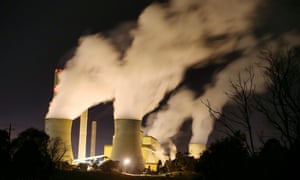Extract from The Guardian
Australia’s emissions from electricity generation continue to rise and are now 5.5% higher than when the carbon price was repealed, new data reveals.
The environment minister, Greg Hunt, claimed recently that Australia’s total greenhouse emissions had “peaked” in 2005.
Declining electricity demand has been dampening electricity emissions and reducing the total increase in greenhouse emissions despite increases in emissions from land clearing and mining.
But the latest data from Pitt and Sherry for the year to March 2016 shows total demand in the east coast electricity market increased for the 13th successive month and demand increased for the seventh successive month in the west.
“There can be little doubt that the period of falling demand for electricity across Australia has now ended,” said Pitt and Sherry analyst Hugh Saddler.
That increasing demand and an increase in generation using black coal, after the removal of the carbon price, saw annual emissions increase 5.5% in the year to March 2016, compared with the year to June 2014, when the carbon price was scrapped.
Total coal generation was 76.1%, compared with a minimum of 72.3% in the year to July 2014. Total renewable generation was 13.2%. Coal generation in Queensland is rising particularly quickly to fuel the booming liquefied natural gas export market. Those emissions will soon comprise an extra 8m tonnes of CO2 a year.
Brown coal emissions fell slightly in the year to March 2016, almost entirely because Victoria’s brown coal generators stopped exporting power to Tasmania. But Saddler says Tasmania’s energy crisis – caused by low rainfall and the fact that the undersea cable linking the island state to the mainland broke in December – means “large volumes of brown coal electricity are certain to flow south through the Basslink cable as soon as it has been repaired, so as to allow hydro storage levels to recover”.
The revelation that electricity emissions are trending steadily upwards comes as the Turnbull government begins consultations on setting “baselines” for its “safeguard” mechanism, which is supposed to ensure that rising electricity and industrial emissions don’t undo the greenhouse abatement bought through the government’s emissions reduction fund.
The baselines will apply after 2020 for new facilities or significant expansions.
The electricity industry will have a sector-wide baseline, with individual company baselines only kicking in if the sector-wide baseline is exceeded.
But the electricity sectoral baseline will be set at the high point of sectoral emissions over the period 2009-10 to 2013-14 and individual baselines will also be set at each facility’s highest annual emissions between 2009-10 and 2013-14.
The environment minister, Greg Hunt, claimed recently that Australia’s total greenhouse emissions had “peaked” in 2005.
Declining electricity demand has been dampening electricity emissions and reducing the total increase in greenhouse emissions despite increases in emissions from land clearing and mining.
But the latest data from Pitt and Sherry for the year to March 2016 shows total demand in the east coast electricity market increased for the 13th successive month and demand increased for the seventh successive month in the west.
“There can be little doubt that the period of falling demand for electricity across Australia has now ended,” said Pitt and Sherry analyst Hugh Saddler.
That increasing demand and an increase in generation using black coal, after the removal of the carbon price, saw annual emissions increase 5.5% in the year to March 2016, compared with the year to June 2014, when the carbon price was scrapped.
Total coal generation was 76.1%, compared with a minimum of 72.3% in the year to July 2014. Total renewable generation was 13.2%. Coal generation in Queensland is rising particularly quickly to fuel the booming liquefied natural gas export market. Those emissions will soon comprise an extra 8m tonnes of CO2 a year.
Brown coal emissions fell slightly in the year to March 2016, almost entirely because Victoria’s brown coal generators stopped exporting power to Tasmania. But Saddler says Tasmania’s energy crisis – caused by low rainfall and the fact that the undersea cable linking the island state to the mainland broke in December – means “large volumes of brown coal electricity are certain to flow south through the Basslink cable as soon as it has been repaired, so as to allow hydro storage levels to recover”.
The revelation that electricity emissions are trending steadily upwards comes as the Turnbull government begins consultations on setting “baselines” for its “safeguard” mechanism, which is supposed to ensure that rising electricity and industrial emissions don’t undo the greenhouse abatement bought through the government’s emissions reduction fund.
The baselines will apply after 2020 for new facilities or significant expansions.
The electricity industry will have a sector-wide baseline, with individual company baselines only kicking in if the sector-wide baseline is exceeded.
But the electricity sectoral baseline will be set at the high point of sectoral emissions over the period 2009-10 to 2013-14 and individual baselines will also be set at each facility’s highest annual emissions between 2009-10 and 2013-14.

No comments:
Post a Comment